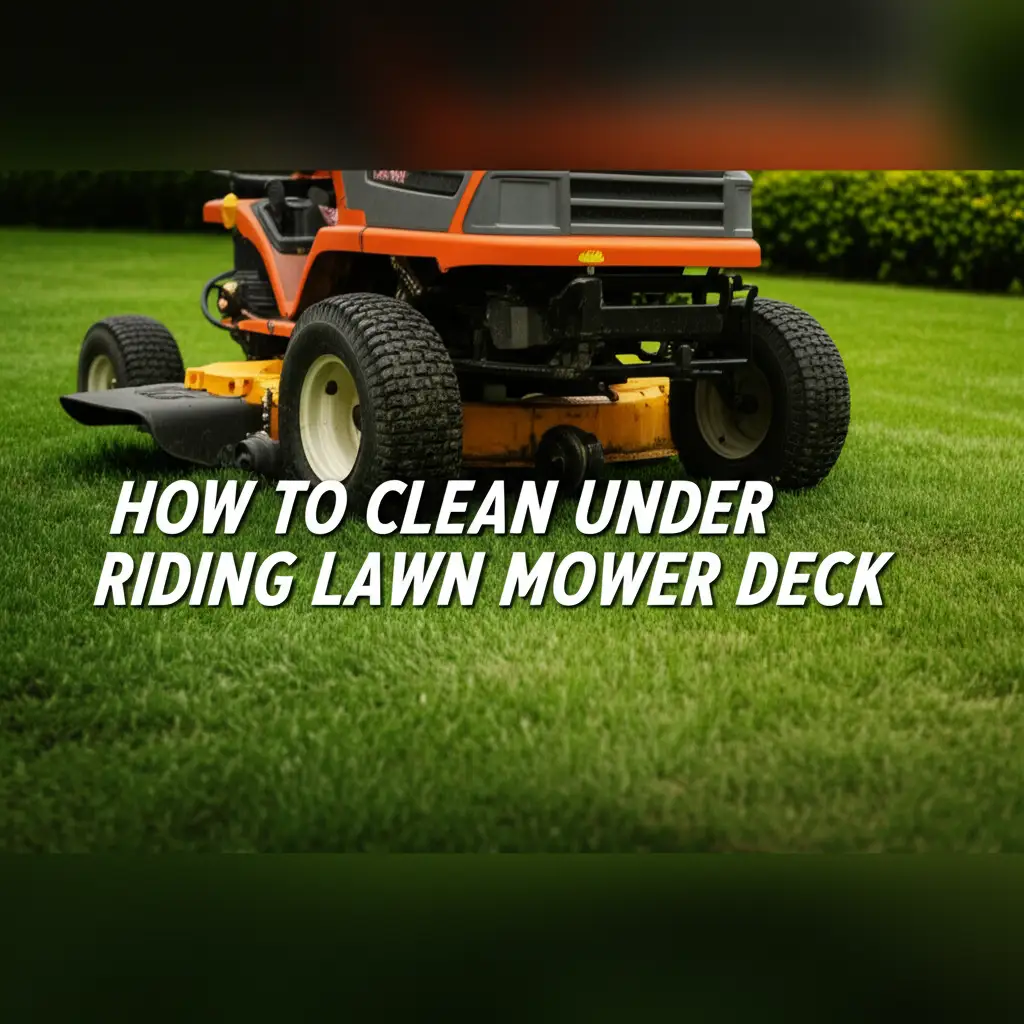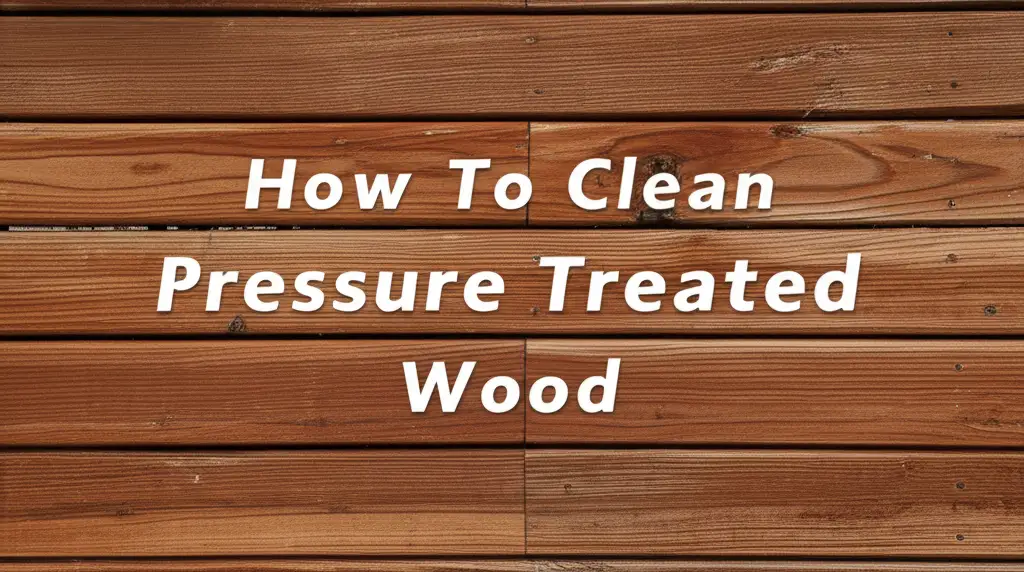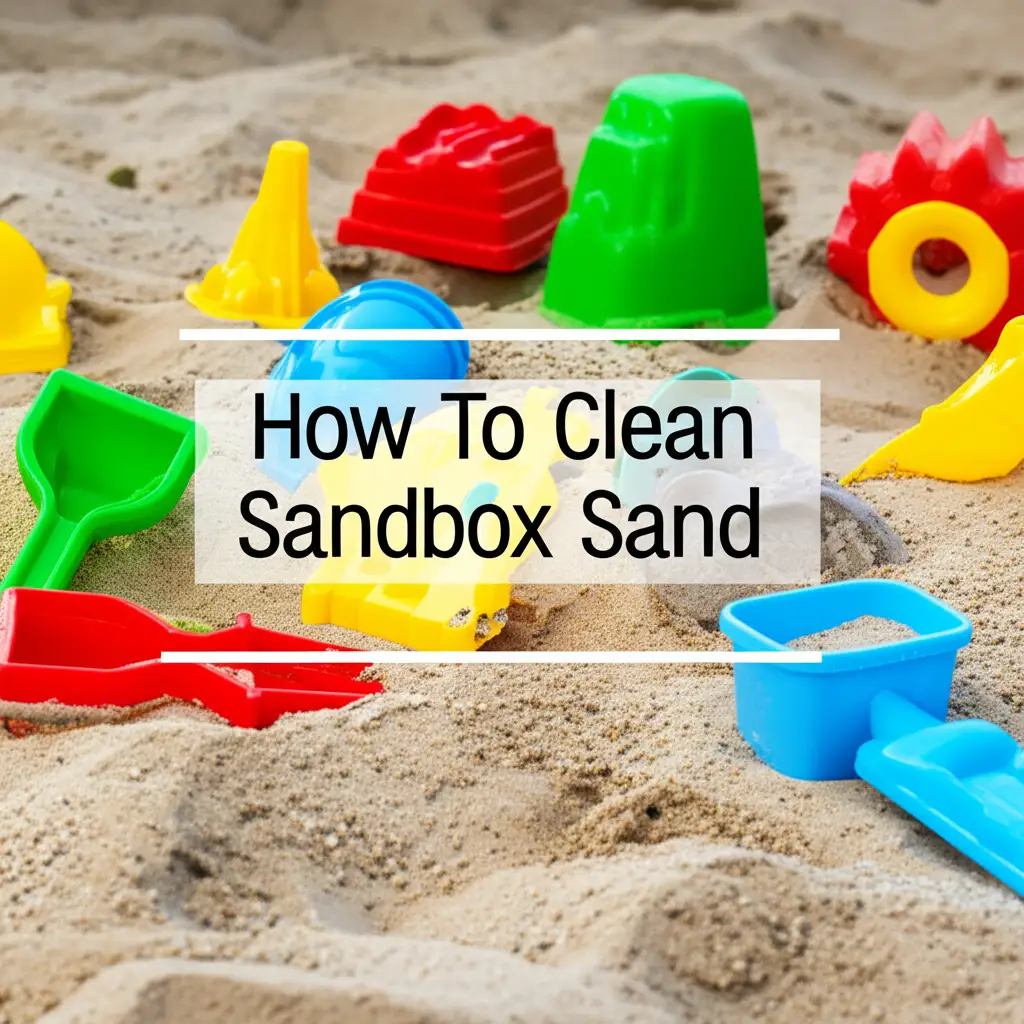· Outdoor Maintenance · 16 min read
How To Clean Under Riding Lawn Mower Deck

Restore Your Mower: How to Clean Under Riding Lawn Mower Deck
Is your riding lawn mower leaving uneven cuts? Does it seem to struggle more than usual? The likely culprit hides underneath: a dirty mower deck. Grass clippings, dirt, and moisture combine to form a thick, sticky layer. This buildup impacts blade performance and mower efficiency.
Learning how to clean under riding lawn mower deck is a simple yet crucial maintenance task. It keeps your machine running smoothly. A clean deck ensures a clean cut and extends the life of your mower. This article will show you each step. We cover safety measures, necessary tools, and effective cleaning methods. You will learn to properly maintain your riding mower deck.
Takeaway
- Safety First: Always disconnect the spark plug and secure the mower before cleaning.
- Gather Tools: Collect a scraper, brush, hose, safety gear, and cleaner.
- Scrape and Wash: Remove large debris with a scraper, then wash with water and detergent.
- Dry Thoroughly: Ensure the deck is completely dry to prevent rust and new buildup.
- Regular Maintenance: Clean your deck often for best mower performance and longevity.
How do you clean under a riding lawn mower deck?
To clean under a riding lawn mower deck, first disconnect the spark plug for safety. Lift and secure the mower deck. Use a scraper to remove large, dried grass clumps. Then, scrub the remaining residue with a stiff brush and water, possibly with a mild detergent. Rinse the area completely and allow it to dry before lowering the mower.
Why Cleaning Your Mower Deck Matters for Performance
A clean mower deck makes a big difference in how your riding lawn mower works. Grass and dirt stick to the underside of the deck. This creates a thick layer over time. This layer affects how the blades spin. It also changes how air moves under the deck.
When the deck is dirty, your mower struggles. Blades cannot cut grass cleanly. They rip it instead. This damages your lawn. A dirty deck also makes your mower work harder. It uses more fuel and wears out faster. Regular cleaning prevents these problems. It keeps your mower efficient and strong.
Benefits of a Clean Deck
Cleaning your mower deck provides many benefits. First, it ensures a better quality cut. Your blades spin freely and slice grass evenly. This leaves your lawn looking neat and healthy. Second, a clean deck helps prevent rust. Moisture trapped in grass buildup causes metal to corrode. Removing the buildup protects your mower’s lifespan.
Third, your mower uses less fuel. A clean deck allows blades to spin without resistance. This means the engine does not work as hard. You save money on gas. Fourth, cleaning helps you spot problems early. You can check blades for damage or wear. You can look for loose bolts or other issues. A clean mower is a safe mower.
Signs Your Deck Needs Cleaning
Your mower will tell you when its deck needs cleaning. Watch for specific signs. One common sign is poor cutting performance. The mower leaves ragged grass or misses spots. This happens because grass buildup prevents blades from lifting properly. Another sign is reduced power. The engine strains during mowing. It feels sluggish.
Excessive vibration is also a warning. Unbalanced grass clumps can throw the blades off. This causes the entire mower to shake. You might also notice an increase in fuel consumption. A dirty deck forces the engine to burn more gas. If you see clumps of wet grass stuck to the underside after mowing, it is time to clean. Do not wait until these problems become severe. Act quickly to clean your deck.
Safety First: Preparing Your Riding Mower for Cleaning
Before you start cleaning under your riding lawn mower deck, safety is most important. Working under a mower deck can be dangerous. Blades are sharp. The engine can start unexpectedly. You must take steps to protect yourself. Do not rush this part of the process.
Proper preparation prevents accidents. It ensures a safe working environment. Never begin cleaning without following these safety measures. Your well-being depends on them. Think about what could go wrong, and prevent it.
Essential Safety Gear
Wearing the right safety gear protects you from harm. Put on heavy-duty gloves. These protect your hands from sharp blades and rough surfaces. Safety glasses are also crucial. They shield your eyes from debris that might fall. Sturdy work boots provide good grip. They also protect your feet if something heavy drops.
Consider wearing long sleeves and pants. This prevents scrapes and cuts. Do not wear loose clothing that can get caught in parts. Some people also use ear protection. Mowers can be loud, even when off, if you hit metal. Always put on all safety gear before you approach the mower.
Securing Your Mower
Securing the mower correctly is critical. First, turn off the engine completely. Take the key out of the ignition. Next, find the spark plug wire. This wire delivers power to the engine. Pull the spark plug wire off the spark plug. This prevents the engine from accidentally starting. It ensures the blades cannot move.
Now, you must lift the mower deck. Use a strong jack or lift system. Never rely on the mower’s own lift. Once lifted, support the mower with jack stands. Place them under the sturdy parts of the frame. Make sure the mower is stable. It should not wobble or shift. A falling mower causes severe injury. Double-check its stability before you go under it.
Gathering Your Tools for Deck Cleaning
Having the right tools ready makes the cleaning job much easier. You do not want to stop mid-task to find something. Gather all your supplies before you begin. This saves time and effort. The correct tools also ensure a thorough cleaning.
Some tools remove tough, caked-on grass. Others help with washing and drying. Think about the type of buildup you expect. Your tool choice can vary slightly based on this. Prepare everything nearby before you start working under the mower.
Basic Cleaning Tools
You will need a few basic tools for most deck cleaning jobs. A stiff-bristled brush is essential. It helps scrub away stuck-on debris. A flat scraper or putty knife works well for removing large clumps of dried grass. Some people prefer a plastic scraper to avoid scratching the deck. A garden hose with a strong nozzle is necessary for rinsing.
You might also need a bucket of warm water. Add a mild detergent to the water. Dish soap often works fine. Keep an old rag or sponge handy for wiping. These basic items will handle most routine deck cleaning tasks. They are simple, effective, and easy to find.
Advanced Cleaning Aids
For very tough buildup, you might need extra cleaning aids. A pressure washer can quickly blast away stubborn grime. Use a wide-angle nozzle to avoid damaging the deck. Be careful not to direct high pressure at sensitive components. A degreaser or specialized mower deck cleaner can help break down sticky, oily residues. These products often come in spray bottles.
Consider using an anti-stick spray after cleaning. These sprays create a slick surface. They make it harder for new grass clippings to stick. This keeps your deck cleaner for longer. Rust-inhibiting paint or primer can protect any exposed metal. Apply it after the deck is completely dry. These advanced aids make future cleaning easier.
Step-by-Step Guide to Removing Debris
Once your mower is secure and your tools are ready, you can start removing the debris. This part of the job requires some physical effort. The goal is to get rid of all the packed grass and dirt. Work systematically from one end of the deck to the other.
This process involves scraping and brushing. It might be messy. Wear old clothes. This section will guide you through the effective removal of unwanted buildup. We aim to clear the deck completely.
Lifting the Mower Safely
Before you can clean, you must safely lift the mower. Choose a flat, stable surface for this task. Concrete driveways work well. Engage the mower’s parking brake. Disconnect the spark plug wire as previously mentioned. This step is critical for safety.
Use a car jack or a specialized mower lift. Position the jack under a sturdy part of the mower’s frame, not the deck itself. Slowly lift the front or side of the mower until the deck is accessible. Once lifted, place jack stands under the frame to support the weight. Never work under a mower supported only by a jack. Ensure it is perfectly stable before you proceed.
The Scraping Process
Now, begin the scraping. This is often the dirtiest part of cleaning the deck. Use your flat scraper or putty knife. Start at one edge of the deck. Push the scraper under the thickest parts of dried grass and dirt. The goal is to chip away the large, caked-on clumps. You might need to apply a lot of force.
Work your way across the entire underside of the deck. Pay special attention to areas around the blades and the discharge chute. Buildup is often heaviest in these spots. Collect the scraped debris in a tarp or newspaper. This makes cleanup easier later. For very tough, baked-on crud, you may find methods for removing similar stubborn residues helpful, like learning how to clean crud off a cast iron skillet. The principles of scraping away dried, hard material apply here.
Brushing Away Loose Debris
After scraping, you will have loose debris and smaller stuck-on bits. Use your stiff-bristled brush for this step. Scrub the entire deck surface. This removes any remaining smaller clumps. It also loosens up any dust or fine dirt particles. Brush around the blades and spindles.
Ensure you get into all the corners and crevices. A smaller brush, like a wire brush, can help with extremely stubborn areas. Be careful not to damage any wiring or components. Brush everything onto your tarp below. This readies the deck for washing. The brushing prepares the surface for a more thorough clean.
Washing and Drying the Mower Deck
Once you have scraped and brushed away the heavy debris, it is time for a wet clean. This step removes fine particles and makes the deck spotless. Proper washing prevents further buildup. It also helps to prevent rust.
Drying the deck thoroughly is just as important as washing it. Any remaining moisture can lead to corrosion. Take your time with these steps. A well-washed and dried deck is ready for many more mowing sessions.
Applying Cleaning Solutions
You can use a simple mixture of warm water and dish soap. Fill your bucket with this solution. Apply it to the deck using a sponge or a soft brush. Let the solution sit for a few minutes. This helps to loosen any remaining grime. For tougher spots, a degreaser or a specialized mower deck cleaner can be sprayed on.
Scrub the deck again with your stiff brush. Focus on any areas that still look dirty. The soap helps lift dirt and grease. You want the entire underside of the deck to be clean. This includes the blade housing and the chute. Think of it like a deep clean for an appliance; sometimes, a mild solution like those used for cleaning a dishwasher with vinegar and baking soda can offer valuable lessons in breaking down grime. The same careful application and scrubbing can benefit your mower deck.
Rinsing and Drying Techniques
After scrubbing with your cleaning solution, rinse the deck thoroughly. Use your garden hose with a strong nozzle. Aim the water to wash away all soap and loosened dirt. Make sure no soap residue remains. Soap can attract more dirt if not fully rinsed. If you used a pressure washer for initial debris removal, use it again carefully for rinsing.
Drying is a critical step. Do not skip it. Air dry the deck completely if possible. You can also use a leaf blower to speed up the process. Wipe down metal surfaces with an old towel. Any moisture left behind can cause rust. A perfectly dry deck is ready for storage or immediate use. Ensure every surface is dry before lowering the mower.
Protecting Your Mower Deck from Future Buildup
Cleaning your mower deck takes effort. You want to make that effort last. Protecting the deck from future buildup saves you time later. It also keeps your mower performing at its best. Prevention is often easier than cleaning.
There are simple steps you can take after cleaning. These steps create a barrier against grass and dirt. They make your next clean-up much faster. Think about these protective measures as part of your regular maintenance routine.
Preventing Grass Buildup
Applying a protective coating can significantly reduce grass buildup. After your deck is completely dry, consider using a non-stick spray. These sprays are designed for mower decks. They create a slick surface. Grass clippings have a hard time sticking to it. This means less will accumulate.
Another tip is to mow when the grass is dry. Wet grass sticks to the deck much more easily. Avoid mowing immediately after rain or heavy dew. Adjust your mowing height correctly. Cutting too low can cause more buildup. Regular, shorter cuts produce smaller clippings. These are less likely to clump. These small habits save you from heavy cleaning jobs.
Post-Cleaning Maintenance
After cleaning and optionally applying a protective spray, perform a quick check. Inspect the blades for any nicks or dull spots. Sharpen them if needed. This improves cutting performance. Check all bolts and fasteners. Ensure they are tight. Vibration can loosen them over time.
You can also apply a thin layer of grease or a rust inhibitor to any moving parts under the deck. This protects against moisture and corrosion. Store your mower in a dry place. This prevents rust when it is not in use. A little post-cleaning care goes a long way. It ensures your mower is ready for its next job.
Troubleshooting Common Mower Deck Cleaning Challenges
Sometimes, cleaning a mower deck presents specific challenges. You might encounter very stubborn grime. Rust could be a problem. Accessing certain areas can also prove difficult. These issues require specific approaches.
Do not get discouraged if your deck is extra dirty. There are ways to handle these tougher situations. Knowing how to troubleshoot helps you complete the job effectively. These tips will help you tackle common obstacles.
Tackling Stubborn Stains
Very stubborn stains often come from old, dried grass or oil. Simple soap and water may not remove them. For these stains, consider using a stronger degreaser or an automotive-grade cleaner. Apply the cleaner directly to the stain. Let it soak for the time recommended on the product label. Then, scrub with a stiff brush or a wire brush.
You might need to repeat this process. For extremely baked-on residues, think about the techniques for removing tough, burnt substances, like when you need to know how to clean burnt grease from bottom of frying pans. The principles of letting a strong cleaner penetrate and then using abrasive action are similar. Another comparable situation is learning how to clean burnt oil from stainless steel pan. These methods teach you to be patient and use the right tools for tough spots.
Addressing Rust Spots
Rust can appear on metal parts of the mower deck, especially if it stays wet. Small rust spots can be removed. Use a wire brush or sandpaper. Scrub the rust away until you see bare metal. For larger rust areas, you might need a rust converter product. These products chemically change the rust.
After removing rust, protect the exposed metal. Apply a rust-inhibiting primer. Then, paint over it with a durable, outdoor-grade paint. This seals the metal. It prevents new rust from forming. Regular cleaning helps prevent rust from starting in the first place. Catching rust early saves the deck from greater damage.
Dealing with Difficult Access
Some areas under the mower deck are hard to reach. The space around the blades can be tight. The discharge chute might have hidden corners. For these spots, use smaller tools. A long-handled brush with a narrow head can help. A bottle brush also works well for small openings.
You can also use an air compressor with a nozzle. This can blow out loose debris from tight spaces. Consider angling the mower differently if possible. Sometimes, lifting one side slightly higher gives better access. Always prioritize safety. Do not force your hand into tight spots near blades. Use tools that keep your hands safe and away from sharp edges.
FAQ Section
How often should I clean my mower deck?
Clean your mower deck at least once a month during the mowing season. If you mow tall, wet grass frequently, clean it more often. A quick scrape after each use is also helpful. Regular cleaning prevents heavy buildup. This makes the big cleaning jobs easier. It keeps your mower working well.
Can I use a pressure washer to clean the deck?
Yes, you can use a pressure washer. It quickly removes heavy buildup. Use a wide-angle nozzle to avoid damage. Keep the nozzle a safe distance from the deck. Do not spray directly at seals, bearings, or electrical components. High pressure can force water into these areas. This causes damage.
What happens if I don’t clean my mower deck?
Not cleaning your mower deck leads to several problems. Grass buildup makes blades less effective. Your mower leaves uneven cuts. The engine works harder, using more fuel. This causes faster wear on parts. It also increases the risk of rust. A dirty deck can also create uneven lawn cutting.
Is it safe to clean the blades?
Yes, it is safe to clean the blades, but with extreme caution. Always disconnect the spark plug first. Wear thick gloves. The blades are very sharp. Use a scraper or wire brush to remove grass. You can also sharpen the blades if needed. Always keep your hands clear of the cutting edge.
What’s the best way to prevent grass from sticking?
The best way to prevent grass from sticking is to mow dry grass. Wet grass clings more easily. Apply a non-stick spray to the clean, dry deck. This creates a slick surface. Avoid cutting grass too short. Small clippings are less likely to clump. This keeps the deck cleaner longer.
Can I use household cleaners on the deck?
You can use mild household cleaners, like dish soap mixed with water. Avoid harsh chemicals or abrasive cleaners. These can damage the paint or metal. Always rinse the deck thoroughly after using any cleaner. Ensure no residue remains. Test any new cleaner in a small, hidden area first.
Conclusion
Keeping the underside of your riding lawn mower deck clean is essential. It is not just about looks; it impacts your mower’s performance. A clean deck ensures sharper cuts and extends the life of your machine. It helps your mower run more efficiently, saving you fuel and repair costs. By following the steps outlined, you can easily handle this maintenance task.
Remember to prioritize safety above all else. Always disconnect the spark plug. Use proper lifting and securing methods. Gather your tools before you start. Scrape away the thick grime, then wash the deck thoroughly. Finally, ensure the deck is completely dry to prevent rust. Implement preventative measures to make future cleaning easier. A little effort to clean under riding lawn mower deck goes a long way. Make it a regular part of your lawn care routine. Your mower, and your lawn, will thank you.
- riding mower cleaning
- lawn mower deck maintenance
- grass buildup removal
- mower deck scraping
- mower blade cleaning




